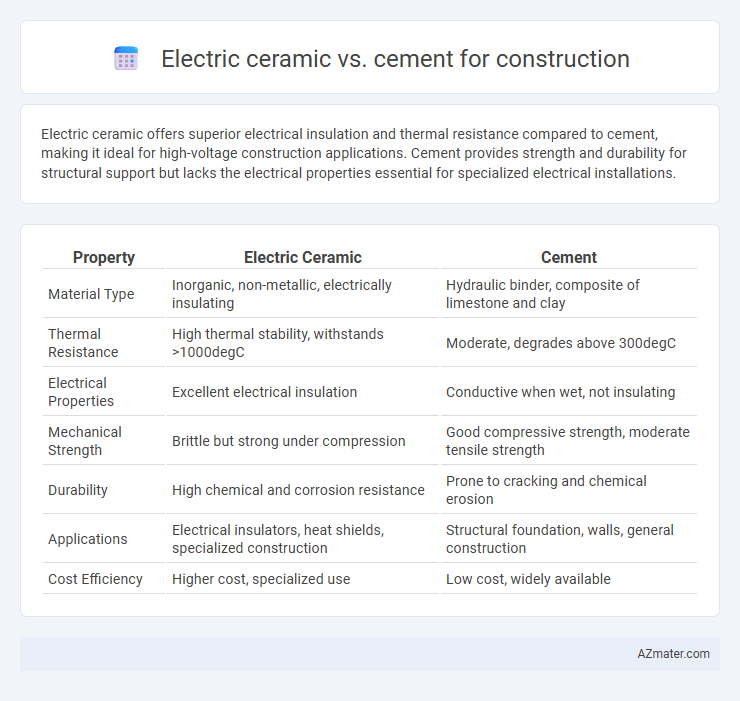Electric ceramic offers superior electrical insulation and thermal resistance compared to cement, making it ideal for high-voltage construction applications. Cement provides strength and durability for structural support but lacks the electrical properties essential for specialized electrical installations.
Table of Comparison
| Property | Electric Ceramic | Cement |
|---|---|---|
| Material Type | Inorganic, non-metallic, electrically insulating | Hydraulic binder, composite of limestone and clay |
| Thermal Resistance | High thermal stability, withstands >1000degC | Moderate, degrades above 300degC |
| Electrical Properties | Excellent electrical insulation | Conductive when wet, not insulating |
| Mechanical Strength | Brittle but strong under compression | Good compressive strength, moderate tensile strength |
| Durability | High chemical and corrosion resistance | Prone to cracking and chemical erosion |
| Applications | Electrical insulators, heat shields, specialized construction | Structural foundation, walls, general construction |
| Cost Efficiency | Higher cost, specialized use | Low cost, widely available |
Introduction to Electric Ceramic and Cement in Construction
Electric ceramics in construction offer high thermal resistance, electrical insulation, and durability, making them ideal for specialized applications such as electrical insulation and heat-resistant components. Cement, primarily Portland cement, serves as the fundamental binding material in concrete and mortar, providing compressive strength and structural integrity for buildings and infrastructure. Both materials contribute distinct functional properties essential for modern construction, with electric ceramics enhancing electrical and thermal performance while cement ensures mechanical stability and longevity.
Material Composition: Electric Ceramic vs Cement
Electric ceramic primarily consists of advanced inorganic materials such as alumina, silicon carbide, and zirconia, engineered for high electrical insulation and thermal resistance. Cement is a composite material made from a mixture of calcium silicates, alumina, iron oxides, and gypsum, designed to harden and bind aggregates in construction. The fundamental difference lies in electric ceramic's crystalline structure tailored for electrical properties, whereas cement's amorphous matrix provides structural strength and durability in building applications.
Strength and Durability Comparison
Electric ceramic materials exhibit higher compressive strength and superior resistance to thermal shock compared to traditional cement, making them ideal for high-stress construction applications. Cement offers good overall durability and flexibility in various environmental conditions but tends to degrade faster under extreme temperature fluctuations and chemical exposure. The enhanced mechanical properties and longevity of electric ceramics provide a compelling advantage in structures requiring exceptional strength and durability.
Energy Efficiency and Thermal Insulation
Electric ceramic materials outperform traditional cement in construction by offering superior thermal insulation, reducing energy consumption for heating and cooling. Their low thermal conductivity enhances building energy efficiency by maintaining stable indoor temperatures and minimizing heat transfer. Cement, while strong and durable, generally lacks the insulating properties necessary to achieve optimal energy savings in modern sustainable architecture.
Sustainability and Environmental Impact
Electric ceramic materials exhibit superior sustainability in construction due to their low thermal conductivity and recyclability, significantly reducing energy consumption and waste during manufacturing and lifecycle use. Cement production, responsible for approximately 8% of global CO2 emissions, contributes heavily to environmental degradation through high energy use and raw material extraction. Incorporating electric ceramic components can lower carbon footprints and promote eco-friendly building practices compared to traditional cement applications.
Installation Process and Flexibility
Electric ceramic tiles offer a straightforward installation process with compatible adhesive systems and pre-wired heating elements, enabling efficient integration into flooring or wall surfaces without extensive modifications. Cement-based construction materials require curing times and more labor-intensive installation steps, often involving specialized mixing and formwork for structural applications. Electric ceramics provide enhanced flexibility for retrofitting and design adjustments due to modularity and lower installation complexity compared to the rigidity and permanence of cement structures.
Cost Analysis: Electric Ceramic vs Cement
Electric ceramic materials typically incur higher initial costs compared to cement due to advanced manufacturing processes and specialized applications in construction. Cement remains more cost-effective for large-scale construction projects because of its widespread availability, lower material price, and established supply chains. Long-term expenses for electric ceramic may be offset by energy efficiency and durability benefits, but upfront budget considerations often favor cement in cost analysis.
Applications in Modern Construction Projects
Electric ceramic materials offer superior thermal insulation and electrical conductivity control, making them ideal for high-tech building components such as smart facades, sensor integration, and energy-efficient heating systems in modern construction projects. Cement remains essential for structural foundations, load-bearing walls, and infrastructure due to its high compressive strength, versatility, and cost-effectiveness in large-scale construction. Integration of electric ceramics enhances the durability and functionality of buildings, while cement ensures stability and long-term performance in diverse construction environments.
Maintenance and Longevity Considerations
Electric ceramic materials in construction offer superior durability and require minimal maintenance due to their high resistance to wear, thermal shock, and chemical corrosion compared to traditional cement. Cement structures, while cost-effective initially, often demand frequent upkeep such as crack repairs, resurfacing, and sealing to maintain structural integrity over time. Longevity of electric ceramics surpasses cement by decades, making them a cost-efficient choice in projects where long-term durability and reduced maintenance are critical.
Future Trends and Innovations in Building Materials
Electric ceramics are emerging as a revolutionary building material with superior thermal insulation, durability, and energy efficiency compared to traditional cement. Innovations in nano-engineered electric ceramic composites enable self-healing properties and enhanced structural strength, promising longer-lasting infrastructure and reduced maintenance costs. Future trends indicate increased integration of smart electric ceramics with embedded sensors for real-time monitoring and adaptive responses to environmental conditions, driving sustainable construction forward.

Infographic: Electric ceramic vs Cement for Construction
 azmater.com
azmater.com